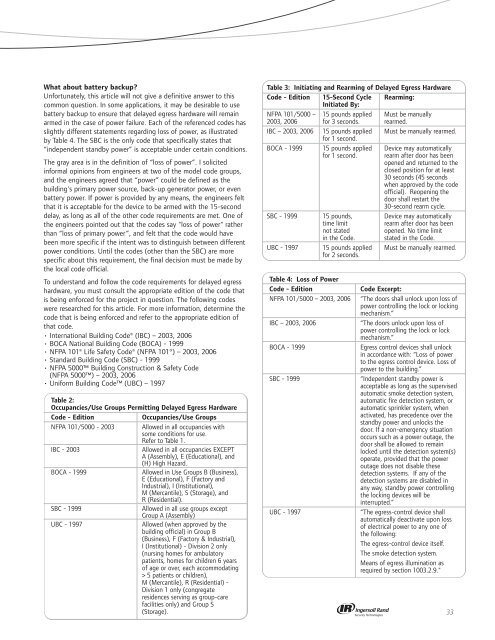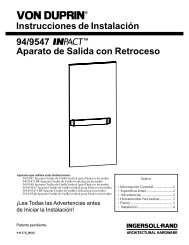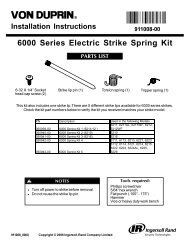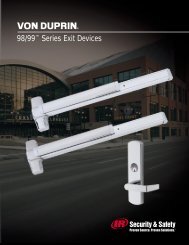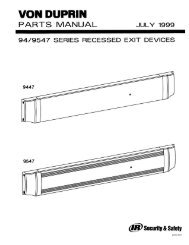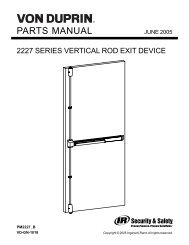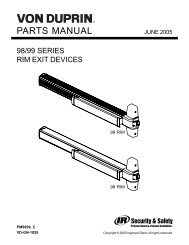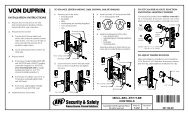Fire, Life Safety & Accessibility Codes - Von Duprin
Fire, Life Safety & Accessibility Codes - Von Duprin
Fire, Life Safety & Accessibility Codes - Von Duprin
You also want an ePaper? Increase the reach of your titles
YUMPU automatically turns print PDFs into web optimized ePapers that Google loves.
What about battery backup?<br />
Unfortunately, this article will not give a definitive answer to this<br />
common question. In some applications, it may be desirable to use<br />
battery backup to ensure that delayed egress hardware will remain<br />
armed in the case of power failure. Each of the referenced codes has<br />
slightly different statements regarding loss of power, as illustrated<br />
by Table 4. The SBC is the only code that specifically states that<br />
“independent standby power” is acceptable under certain conditions.<br />
The gray area is in the definition of “loss of power”. I solicited<br />
informal opinions from engineers at two of the model code groups,<br />
and the engineers agreed that “power” could be defined as the<br />
building's primary power source, back-up generator power, or even<br />
battery power. If power is provided by any means, the engineers felt<br />
that it is acceptable for the device to be armed with the 15-second<br />
delay, as long as all of the other code requirements are met. One of<br />
the engineers pointed out that the codes say "loss of power" rather<br />
than “loss of primary power”, and felt that the code would have<br />
been more specific if the intent was to distinguish between different<br />
power conditions. Until the codes (other than the SBC) are more<br />
specific about this requirement, the final decision must be made by<br />
the local code official.<br />
To understand and follow the code requirements for delayed egress<br />
hardware, you must consult the appropriate edition of the code that<br />
is being enforced for the project in question. The following codes<br />
were researched for this article. For more information, determine the<br />
code that is being enforced and refer to the appropriate edition of<br />
that code.<br />
• International Building Code® (IBC) – 2003, 2006<br />
• BOCA National Building Code (BOCA) - 1999<br />
• NFPA 101® <strong>Life</strong> <strong>Safety</strong> Code® (NFPA 101®) – 2003, 2006<br />
• Standard Building Code (SBC) - 1999<br />
• NFPA 5000 Building Construction & <strong>Safety</strong> Code<br />
(NFPA 5000) – 2003, 2006<br />
• Uniform Building Code (UBC) – 1997<br />
Table 2:<br />
Occupancies/Use Groups Permitting Delayed Egress Hardware<br />
Code - Edition Occupancies/Use Groups<br />
NFPA 101/5000 - 2003 Allowed in all occupancies with<br />
some conditions for use.<br />
Refer to Table 1.<br />
IBC - 2003 Allowed in all occupancies EXCEPT<br />
A (Assembly), E (Educational), and<br />
(H) High Hazard.<br />
BOCA - 1999 Allowed in Use Groups B (Business),<br />
E (Educational), F (Factory and<br />
Industrial), I (Institutional),<br />
M (Mercantile), S (Storage), and<br />
R (Residential).<br />
SBC - 1999 Allowed in all use groups except<br />
Group A (Assembly)<br />
UBC - 1997 Allowed (when approved by the<br />
building official) in Group B<br />
(Business), F (Factory & Industrial),<br />
I (Institutional) - Division 2 only<br />
(nursing homes for ambulatory<br />
patients, homes for children 6 years<br />
of age or over, each accommodating<br />
> 5 patients or children),<br />
M (Mercantile), R (Residential) -<br />
Division 1 only (congregate<br />
residences serving as group-care<br />
facilities only) and Group S<br />
(Storage).<br />
Table 3: Initiating and Rearming of Delayed Egress Hardware<br />
Code - Edition 15-Second Cycle Rearming:<br />
Initiated By:<br />
NFPA 101/5000 – 15 pounds applied Must be manually<br />
2003, 2006 for 3 seconds. rearmed.<br />
IBC – 2003, 2006 15 pounds applied Must be manually rearmed.<br />
for 1 second.<br />
BOCA - 1999 15 pounds applied Device may automatically<br />
for 1 second. rearm after door has been<br />
opened and returned to the<br />
closed position for at least<br />
30 seconds (45 seconds<br />
when approved by the code<br />
official). Reopening the<br />
door shall restart the<br />
30-second rearm cycle.<br />
SBC - 1999 15 pounds, Device may automatically<br />
time limit rearm after door has been<br />
not stated opened. No time limit<br />
in the Code. stated in the Code.<br />
UBC - 1997 15 pounds applied Must be manually rearmed.<br />
for 2 seconds.<br />
Table4: LossofPower<br />
Code - Edition Code Excerpt:<br />
NFPA 101/5000 – 2003, 2006 “The doors shall unlock upon loss of<br />
power controlling the lock or locking<br />
mechanism.”<br />
IBC – 2003, 2006 “The doors unlock upon loss of<br />
power controlling the lock or lock<br />
mechanism.”<br />
BOCA - 1999 Egress control devices shall unlock<br />
in accordance with: “Loss of power<br />
to the egress control device. Loss of<br />
power to the building.”<br />
SBC - 1999 “Independent standby power is<br />
acceptable as long as the supervised<br />
automatic smoke detection system,<br />
automatic fire detection system, or<br />
automatic sprinkler system, when<br />
activated, has precedence over the<br />
standby power and unlocks the<br />
door. If a non-emergency situation<br />
occurs such as a power outage, the<br />
door shall be allowed to remain<br />
locked until the detection system(s)<br />
operate, provided that the power<br />
outage does not disable these<br />
detection systems. If any of the<br />
detection systems are disabled in<br />
any way, standby power controlling<br />
the locking devices will be<br />
interrupted.”<br />
UBC - 1997 “The egress-control device shall<br />
automatically deactivate upon loss<br />
of electrical power to any one of<br />
the following:<br />
The egress-control device itself.<br />
The smoke detection system.<br />
Means of egress illumination as<br />
required by section 1003.2.9."<br />
33


